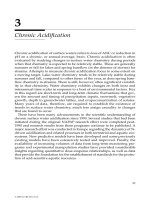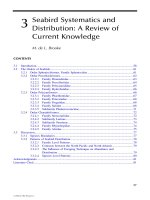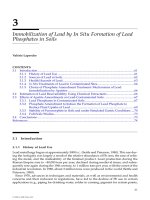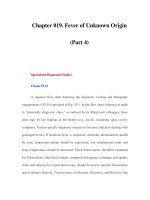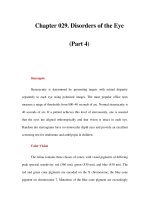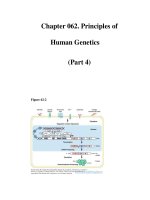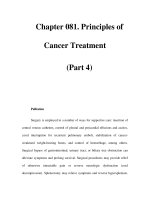Chapter 3 dimensions of word meaning group 4
Bạn đang xem bản rút gọn của tài liệu. Xem và tải ngay bản đầy đủ của tài liệu tại đây (316.35 KB, 22 trang )
THUONGMAI UNIVERSITY
FALCUTY OF ENGLISH
LINGUISTIC DIVISION
--------
ASSIGNMENT
TOPIC: DIMENSIONS OF WORD MEANING
Course
:
Semantics
Lecturer
:
Nguyen Thi Thuy Chung
Group
:
04
Class code :
H2001ENTH0911
Ha Noi - 2020
Chapter 3: Dimensions of word meaning
MEMBERS OF GROUP 04
No
Student’s
card
Name
1
18D170120
Bui Thi Thu Huong
2
17D170134
Le Thi Huyen N3
3
17D170195
Le Thi Huyen N4
4
17D170015
Nguyen Thi Thanh Huyen
5
18D1700167
Tran Khanh Huyen
6
17D170316
Ho Thai Khanh
7
17D170317
Pham Thi Kim
8
18D170198
Vu Thi Thuy Lam
9
17D170018
Phung Thi Thanh Lan
10
17D170078
Ta Thanh Lan
Self
Evaluation
Leader
Evaluation
Group’s Leader
Ho Thai Khanh
MEETING MINUTES
Topic:
Date of
Meeting:
Meeting
Purpose:
Dimensions of word meaning
01/07/2020
Discuss the topic and
assign tasks to
member
Time:
2:30 PM – 4:00 PM
Leader:
Ho Thai Khanh
Chapter 3: Dimensions of word meaning
1. Attendance at Meeting
10 members
Name
Position
Ho Thai Khanh
Group leader
Bui Thi Thu Huong
Group member
Le Thi Huyen N3
Group member
Le Thi Huyen N4
Group member
Nguyen Thi Thanh Huyen
Group member
Tran Khanh Huyen
Group member
Pham Thi Kim
Group member
Vu Thi Thuy Lam
Group member
Phung Thi Thanh Lan
Group member
Ta Thanh Lan
Secretary
2. Content of the meeting
Deciding on the outline of the assignment:
Assigning tasks to each member
Deciding on the due dates of tasks:
- Deadline: 08/07/2020
3. Duties
Outline
1. Introduction
2. Naming
3. Denotation, Reference and Sense
Words
Ho Thai Khanh
(Slide)
Presenter
Ho Thai Khanh
Chapter 3: Dimensions of word meaning
4. The change and development of
meaning
4.1. Definition of semantic change
Vu Thi Thuy Lam
Phung Thi Thanh
Lan
Pham Thi Kim
Nguyen Thi Thanh
Huyen
4.2.Causes of semantic change
4.3. Nature of semantic change
5. Transference of meaning
5.1. Metaphor
5.1.1. Definition
5.1.2. The difference between
metaphor and simile
5.1.3. Some basis of metaphor
transference
5.2. Metonymy
5.2.1. Definition
5.2.2. The cases of metonymy
Bui Thi
Thu Huong
Le Thi Huyen N3
5.2.3. Metaphor vs metonymy
5.3. Others ( definition + examples)
5.3.1. Hyperbole
5.3.2. Litotes
Tran Khanh Huyen
5.3.3. Irony
Le Thi Huyen N4
5.3.4. Euphemism
6. Practice exercises
Ta Thanh Lan
Wednesday, July 1st, 2020
Chapter 3: Dimensions of word meaning
Group’s leader
Ho Thai Khanh
TABLE OF CONTENT
1. Introduction
English is a language that has been taught in Vietnam for decades and it is
considered to be an international language used in many fields. Nowadays,
English is widely recognized as the key language in the integration process into
the world. To have a good command of English, Vietnamese leaners have to face a
lot of difficulties such as using English grammar, using vocabulary, etc.
In English, words are not always used directly or literally, and sometimes
they might have more than just one meaning. To define and clarify the meaning of
the words have never been an easy task for linguists. There have been many
attempts designed to define what the meanings of the word are. Traditionally,
linguists have referred to the meaning of words in two parts that are denotation
and connotation. For example, when someone gives you a rose, we can see that a
rose in denotative meaning is a red rose with a green stem, but in the connotative
meaning, it is a symbol of passion and love – so when they give you a rose, it
means that they love you. But sometimes we don‘t pay attention to that and
sometimes we misunderstand and get confused.
However, linguists also realize the need to distinguish what a word or
expression denotes from what they can be used to refer to, that is, to tell the
difference between denotation and reference. There is also another dimension to
the lexical meaning of words such as “man, star”, that is traditionally called sense.
Studying semantic in general and the components of word meaning, in
particular, are necessary for students of English so that we can understand and use
them more effectively. This study will be analyzing the different layers of word
meaning and discuss how the meaning of words can change and develop.
2. Naming
Human beings name things in their environment. The name helps to
distinguish and identify what the thing is and is essential to communicate with a
fellow human. In Plato’s Cratylus, he stated that the word is a signifier that stands
for an object.
7
While this idea works very well with nouns which are usually used to
denote objects, it doesn’t work well with nouns denoting abstract concepts such
as love, hate, and anger. Moreover, when dealing with other parts of speech such
as prepositions, adjectives, articles, etc, it is difficult to extend this theory to
include these parts of speech. For example, it is almost impossible to name an
action like “flowing” because one can visualize the image of the river flowing but
the issue of naming “flowing” is almost out of the question.
However, this theory is useful in some other situations, such as
distinguishing two kinds of worlds, one is the real worlds containing those objects
as we know them, the real world and the imaginary world made up of things such
as unicorn, ogre, fairy, the imaginary world.
3. Denotation, Reference and Sense
3.1. Denotation and Reference
The differences between denotation and reference are that denotation is
the ability of a word to identify all those things or objects that are covered by it
while reference is the relationship between a word and what it refers to. Referring
is what speakers do and denoting is a property of words
For example: The fat man is talking.
In this sentence, “the fat man” will evoke the image of an overweight man
which is the denotative meaning of the words. However, when put in a specific
context, such as when the president of the USA is talking, we can understand that
the fat man here refers to Donald Trump. When put in a specific context like this,
the denotative meaning of the word “fat” hasn’t changed because the president of
the USA can be correctly described as “fat” and the only thing that changes is who
the speaker is referring to, a man in general or the president of the USA.
As you can see, depends on the context, a word can refer to different things
and have different meanings, however, no matter what the context is, a word will
have the same denotation meaning. This is why the denotation of a word or
expression is invariant and utterance independent while the reference is variable
8
and utterance dependent. By making a reference, a speaker wants to indicate a
particular thing in a particular situation, not a thing in general.
3.2. Reference of Sense
Another aspect of word meaning is the sense of the word. While the
reference deals with the relationships between language and the word, sense
deals with the relationship inside language itself.
For example: Watch out for the dog
In this sentence, “the dog” is used to refer to the actual dog in the real
world. When making this utterance, the speaker wants to refer to the dog in the
real world that the listener has to watch out for. However, what if the person who
heard this utterance has not seen the actual dog yet, then they will first form a
mental image of what a dog is inside their head, which is possible thanks to the
sense of the word “dog”.
The sense of a word is the mental representation of that word, an abstract
concept, and not a physical object while the reference of a word is the physical
representation of that word in the real world. Sense and reference are generally
interdependent because one would not know what object the word is referring to
without knowing the sense of that word first.
For example: Watch out for the python
If the person who listens to this utterance has not seen what a python is
which means they don’t know the sense of the word “python” then they won’t be
able to understand what the speaker wants to refer to.
4. The change and development of meaning
4.1. Definition of semantic change
Semantic change is a form of language change regarding the evolution of
word usage. The development of vocabulary is first of all reflected in the
development of semantic structure of the words: new meanings of the words
appear; some old meanings drop out of the language or coexist with the new ones.
9
E.g.:
- New meanings of the words appear:
•
“Awful” originally meant "inspiring wonder (or fear)". This word used
originally as a shortening for "full of awe", in contemporary usage the word
usually has negative meaning “extremely bad”.
• The word “relieve” once meant “to make (something) stand out”. Now it
means “to free from a burden”, “to replace or take the place of”.
- Some old meanings drop out of the language or coexist with the new ones
•
The word “silly” once meant “happy” but now its meaning refers to the
foolish.
• The word “husband” in old English meant “master of the house”, now it
means “a man joined to a woman in marriage”.
• The word 'gay' originally meant "lighthearted", "joyous" or "happy". The
word now refers to “a homosexual person”.
4.2. Causes of semantic change
- Extra linguistic causes: connected with the development of society, changes in
social, political, economic, cultural life, in science and technology:
+ Objects are changed or our concepts are changed.
E.g.: The word “space” from the meanings of “extension” or “intervening distance”
came to mean “the limitless expanse in which everything exists” and more recently
came to be used especially in the meaning of “outer space”.
+ The words used by a particular group of people pass into general usage or vice
versa.
E.g.: The word “harvest” has a specific definition in agriculture: “to gather a crop”
but this word also has a more general meaning which is “to receive the benefits or
consequences of an action”.
- Linguistic causes: connected with the system of language:
+ Ellipsis or contraction of a phrase.
E.g.: The verbs “starve” in Old English (OE. Steorfan) had the meaning ‘to die’ and
was habitually used in collocation with the word hunger (ME.Sterven of hunger).
Already in the 16th century the verb itself acquired the meaning “to die of hunger”.
10
+Discrimination of synonyms:
E.g.: The word “land” in Old English meant both “solid part of earth’s surface” and
“the territory of a nation”. When in the Middle English period the word “country”
was borrowed as its synonym, the meaning of the word “land” was somewhat
altered and “the territory of a nation” came to be denoted mainly by the borrowed
word “country”.
+ Attraction of synonyms:
E.g.:
•
The word “catch” acquired the meaning “to understand” and its synonyms
“grasp, get” acquired this meaning too.
• All English adverbs which acquired the meaning “rapidly” (in a certain
period of time - before 1300) always develop the meaning “immediately”.
- Psychological reasons (taboos, euphemisms): concern the avoidance of
expressing explicitly problematic concepts such as death, excretion or sex.
E.g.:
•
The word “crafty” meaning “skilled” is often used as a euphemism of the word
“dishonest”, but the meaning comes from the inference and relates to this
lexical unit.
• The word “pass away” is used to replace the word “die”
4.3. Nature of semantic change
- Change of evolvement of the denotation:
+ Meaning extended: more general or more inclusive than its historically earlier
form:
•
The meaning is widened
E.g.: the word "business", which originally meant "a state of being busy,
careworn or anxious", but has now broadened to include all kinds of work
occupations.
• The meaning is generalized
E.g.: the word “case” has now to be used in quite a range of situations with
its general meaning of “circumstances in which a person or thing is”.
Compare its specialized meaning: a lawsuit or a patient.
11
+ Meaning narrowed: the meaning is specialized, less general or less inclusive
than its historically earlier form:
E.g.:
•
“Queen” firstly used as “wife” but now it is more specific because it is just
used for “the wife of the king”.
• The world “girl”, which originally meant a child of either gender, rather than
a female child.
- Change or evolvement of the connotation
+ Degradation of meaning (deterioration): the meaning of the word becomes
more negative or less favorable.
E.g.:
•
The word “knave”, which originally meant “boy” or “servant” now refers to
“rogue”
• “Vulgar” once was used to denote “common, ordinary” but in modern usage it
means “coarse, low, and ill-bred”.
• The word "accident" once simply meaning "a chance event" now has
associations with misfortune and injury, so we assume that when someone
has "had an accident" it was not a positive experience.
+ Elevation of meaning: the meaning of a word becomes more positive or
favorable.
E.g.:
•
The word "sick" has obvious negative connotations of illness that are still
connected to the word today, but it has also become a popular slang term for
something cool, for example, "that's sick!".
• “A knight” meant “a boy, youth”, but now it means “a noble, courageous man”.
• The word “pretty” once was used to denote “tricky, sly wily”, but now it means
“charming and attractive”.
5. Transference of meaning
5.1. Metaphor
5.1.1. Definition
12
Metaphor is the transference of meaning from one object to another based
on similarity between these two. In other words, we call one object by the name
of another because we compare these objects and find some common features
between them.
Through a metaphor, some qualities are transferred from a source domain
(tangible objects) to a target domain (ideas)
Example: That woman is a witch.
+Target domain: that woman- ugly, cruel
+Source domain: witch – having magic powers and doing evil things.
+Similarity: unpleasant, cruel
5.1.2. The difference between metaphor and simile:
Criteria
Feature
Meaning
Form
Metaphor
Impliedly compare two objects.
Metaphor describes someone or
something by referring to
someone or something else
which is same in a specific way
- It does not use connectives as
it indicates that the subject is
something. In other words, it
has no elements of comparison
-A form of figurative language.
Result
Example
Simile
Direct comparison of two
things
An expression that helps to
compare two varied things,
having
elements
of
comparison (“ as” and “like”)
- We make use of connectives
such as ‘like’ and ‘as’ to
indicate that the subject is
similar to something. In other
words, it has elements of
comparison
-A form of metaphor.
May lead to confusion when Clearly just a comparison
taken literally
-My brother is doraemon.
-Peter is as tall as a giraffe.
-Amir is a live encyclopedia.
-The man
donkey.
laughs
like
-She was the heroine of the
movie
-He argues like a lawyer.
5.1.3. Some basis of metaphor transference
- Shape:
13
a
E.g: Because the nose is a sharpened body part, it is possible to call the pointed
parts of things that are the nose: the bow of a boat, the tip of a knife, the needle of a
needle, etc.
- Position: especially widely used are the metaphoric meaning of word denoting
parts of human body: the manner of the parts of human body are transferred to
other objects
E.g: the nose of a plane, the head of the school, the leg of the table…
- Movement:
E.g: She wormed her way through the crowd.
- Function: finger of instrument, the key to the mystery…
- Color: orange, rose, pink, green…
- Size: midget, elephantine…
5.2. Metonymy
5.2.1. Definition
Metonymy is the substitution of one word for another with which it is
associated. In other word, instead of the name of one object or notion we use the name
of another because these objects are associates and closely related.
Examples:
•
England decides to keep check on immigration. (England refers to the
government.)
• The pen is mightier than the sword. (Pen refers to written words, and sword to
military force.)
• The Oval Office was busy in work. (The Oval Office is a metonymy, as it stands
for people who work in the office.)
5.2.2. Basic of the transference
According to standard traditional, Metonymy is defined as a “figure in which
one word is substituted for another on the basic of some material, causal or conceptual
relation. Some substitutions include: place-for-institution, thing-for-perception, objectfor-possessor, part-for-whole, and place-for-event. Here are exemplified below:
14
•
After
the
protests,
maybe
Washington
will
listen
to
the
voters:
Washington( place) refers to the US government ( institution) -> Place-for•
institution
My brother was just released from the big house: The big house - to refer to
prison, this is American slang and also American perception. -> thing-for-
•
perception
Look lively, the top brass are coming for an audit today: Brass - used in place
of high-ranking officials -> object-for-possessor.
• Can you give me a hand carrying this box up the stairs? : Hand- for help, the
hand here refers to the person who wants to help. -> part-for-whole.
• Dien Bien Phu marked the defeat of the French army. Dien Bien Phu is a place
where the fierce battle between the Vietnamese army and the French army
occurred and we won forced the French army to surrender. -> place-for-event.
5.2.3. Case of metonymy
- Name of parts of human body as symbol
Examples:
•
Tell me about his warm heart: A "warm heart" refers to a very emotional man
who always care about others
• Perfect choice, you have a good eye. “A good eye” that mean this person can be
a very smart or professional on a job.
- Name of container instead of thing contained.
Examples:
•
The box is full. Box is a container with a flat base and sides, typically square or
rectangular and having a lid, used for containing something. Metonymy sense
can be paper /clothes…
• He drank the whole bottle. Bottle is a container, typically made of glass or
plastic and with a narrow neck, used for storing drinks or other liquids.
Metonymy sense can be water, beer or soda…
- The concrete is used instead of abstract.
Example: He had come to the end of the path of a lifetime. The end of the road is not
about the end of a road that people go everyday but about dead.
- The materials are used for the things made of the materials.
Examples:
15
•
Could you lend me that glass? Glass is hard and transparent material and
metonymy sense is a container made of glass.
• There is a silk in the wardrobe. Silk refers to a dress or towel. Silk is a material
used for making clothes …
- The name of author instead of his work.
Examples:
•
I really like reading Nam Cao. Nam Cao is an author of Vietnam. And this
refers to his works.
• I often listen to Beethoven. Beethoven is a famous musician and he has many
beautiful songs and this Beethoven refers to his songs.
- Part for the whole and vice versa
Examples:
•
The team needs some new blood if it is going to win next season. New blood -
used in place of new people, fresh ideas.
• Tell me about head count. Head is part of body of human; head count refers to
amount of people.
- Items of clothing instead of the one who wears them
Example: She always runs after the T-shirt. T-shirt refers to person who wears it.
- Symbol to refer to representative
Examples:
•
Silicon Valley is constantly pushing the boundaries in innovation. Silicon Valley
•
- to refer to the tech industry.
It seems like people will do whatever Hollywood says is cool. Hollywood - to
refer to the film industry.
• America in order to build up a good relationship with Vietnam. America refers
to American government.
- Spatial relation
Example: He was elected chair of the city council. Chair is position of being in charge
of the meeting or a committee. But here, it refers to the person who holds the position
of being in charge of a meeting or a committee.
- Causal relation
16
Example: Fear of failure was bred into him at an early age. Fear mean danger
(original use).The bad feeling that you have when you are in danger.
- Geographical relation
Examples:
She has bought a new pair of China towels. China is a name of country. But
•
here it refers to silk.
• Hanoi won the match yesterday. Hanoi is name of city, but it refers to a sport
team.
- Function relation
Example: She keyboards 10 pages in Excel. “Keyboard” is a panel of keys that operate
a computer or typewriter. But here it refers to enter something.
5.2.4. Metonymy vs. Metaphor
Metonymy
Metaphor
- Based on similarity
- Based on contiguity
E.g. the children were flowers grown in E.g. US dollars have dominated the world
economy for decades.
concrete gardens.
US dollars refer to American economy.
America is always at top 1 of economic
development
5.3. Others
5.3.1. Hyperbole
- Hyperbole is an exaggerated statement not meant to be understood literally but with
powerful effect.
- Examples:
• I've told you to clean your room a million times!
This does not mean that this person has mentioned a million times, using
hyperbole here means to explain that this person has repeated it many times in the past.
• He's got tons of money.
In this example, the speaker claims that he has a ton of money! Of course, this
does not mean that there is actually a ton of money. The speaker is using hyperbole to
emphasize that he has a lot of money
•
The car went faster than the speed of light.
17
In this example, the speaker said that there is a car that runs at the speed of light,
not because the car can actually do that, but the speaker uses hyperbole here to show
that it runs really fast.
•
She’s going to die of embarrassment.
This does not mean that the girl is going to get sick or that her heart will stop due
to embarrassment. Instead, the speaker is using hyperbole to emphasize just how
embarrassed she’s going to feel.
5.3.2. Litotes
- Definition: Litotes is an understatement expressing something in the affirmative by
the negative of its contrary.
- Examples:
•
I cannot disagree with your point of view ( totally agree).
•
You are not doing badly at all (do work good).
•
You are not as young as you used to be (old).
•
Your presentation is not bad (good).
Irony
- Definition: The item “irony” is taken from rhetoric. What it does is to express
5.3.3.
meaning by words of the opposite sence. Here is important to note that important to
note that intonton has a very essential role to play in getting this message across.
- Examples:
• I have just seen a really helpful video on youtube about how to eat with your
mouth.
• (When the weather is raining heavily) “ What a pleasant day”
5.3.4.
Euphemisms
- Definition: Euphemisms involve the use of a milder expression for something
unpleasant.
- Examples:
• “On the streets” instead of “homeless”
18
•
“Correctional facility” instead of “jail”
PRACTICE EXERCISES
Exercise 1: What types of meaning transference do the following sentence belongs
to?
1
He was a lion in the fight.
2
His words stabbed at her heart.
3
I will make him eat his word.
4
His Majesty died 2 years ago.
5
Don’t live in such a sea of doubt!
6
He is so intelligent that no examiner has agreed to pass him so far.
7
I’m afraid he has misrepresented the facts.
8
I am the captain of my soul.
9
We are tired to death of this movie.
10 He is as mute as a fish.
19
Exercise 2: Identify and comment on the type of metaphor and metonymy in the
following sentences:
1
English is the key to success.
2
The White House released a statement last week.
3
He bought a Ford.
4
My dear, you have all of my heart.
5
Her tears were a river flowing down her cheeks.
ANSWER KEYS
Ex1. What types of meaning transference do the following sentence belongs to?
1. Metaphor (the whole sentence means He fought bravely and successfully just like a
lion in the fight for food)
2. Metaphor (“his words” didn’t actually stab, but their effect is implicitly compared to
the stabbing of a knife. So it means that: Like a knife, his words are so sharp that they
can cause great pain or much unhappiness for her.)
3. Metaphor (I’ll make him admit that what he said is wrong)
4. Metonymy (Majesty = the King)
5. Hyperbole (Don’t be too suspicious)
6. Irony (He is stupid)
7. Euphemisms (= He has told lies)
8. Metonymy
20
+ The captain (specific) stands for the leader (generic)
+ My soul (abstract) stands for my life (less abstract or more specific)
9. Hyperbole (Tired to death is an overstatement which mean extremely bored with)
10. Simile (= He rarely speaks or he is quiet.)
Ex2. Identify and comment on the type of metaphor and metonymy in the
following sentences:
1. Faded metaphor
2. Metonymy (Symbol to refer to representative. The White House represents for
the American President)
3. Metonymy (The name of author instead of his works. In this case, Ford refers to a
type of car named after Henry Ford)
4. Metonymy (The concrete instead of the abstract. Heart is an organ of the body that
substitutes for the abstract of love or emotion)
5. Living metaphor (in the sentence, the metaphor is a creative way of saying that
the person is crying a lot. There are so many tears that they remind the writer of a
river)
21
